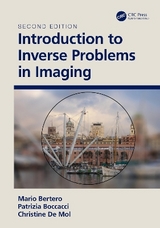
Introduction to Inverse Problems in Imaging
Institute of Physics Publishing (Verlag)
978-0-7503-0435-1 (ISBN)
- Titel erscheint in neuer Auflage
- Artikel merken
This is a graduate textbook on the principles of linear inverse problems, methods of their approximate solution, and practical application in imaging. The level of mathematical treatment is kept as low as possible to make the book suitable for a wide range of readers from different backgrounds in science and engineering. Mathematical prerequisites are first courses in analysis, geometry, linear algebra, probability theory, and Fourier analysis. The authors concentrate on presenting easily implementable and fast solution algorithms. With examples and exercised throughout, the book will provide the reader with the appropriate background for a clear understanding of the essence of inverse problems (ill-posedness and its cure) and, consequently, for an intelligent assessment of the rapidly growing literature on these problems.
INTRODUCTION
What is an inverse problem?
What is an ll-posed problem?
How to cure ill-posedness
An outline of the book
Reference
IMAGE DECONVOLUTION
SOME MATHEMATICAL TOOLS
The Fourier transform (FT)
Bandlimited functions and sampling theorems
Convolution operators
The discrete Fourier transform (DFT)
Cyclic matrices
Relationship between FT and DFT
Discretization of the convolution product
References
EXAMPLES OF IMAGE BLURRING
Blurring and noise
Linear motion blur
Out-of-focus blur
Diffraction-limited imaging systems
Atmospheric turbulence blur
Near-field acoustic holography
References
THE ILL-POSEDNESS OF IMAGE DECONVOLUTION
Formulation of the problem
Well-posed and ill-posed problems
Existence of the solution and inverse filtering
Discretization: from ill-posedness to ill-conditioning
Bandlimited systems: least-squares solutions and generalized solution Approximate solutions and the use of a priori information
Constrained least-squares
References
REGULARIZATION METHODS
Least squares solutions with prescribed energy
Approximate solutions with minimal energy
Regularization algorithms in the sense of Tikhonov
Regularization and filtering
The global point spread function
Choice of the regularization parameter
References
ITERATIVE REGULARIZATION METHODS
The Landweber method
The projected Landweber method for the computation of constrained regularized solutions
The steepest descent and the conjugate gradient method
References
STATISTICAL METHODS
Maximum likelihood (ML) methods
The ML method in the case of Gaussian noise
The ML method in the case of Poisson noise
Bayesian methods
The Wiener filter
References
LINEAR INVERSE IMAGING PROBLEMS
EXAMPLES OF LINEAR INVERSE PROBLEMS
Space-variant imaging systems
X-ray tomography
Emission tomography
Inverse diffraction and inverse source problems
Linearized inverse scattering problems
References
SINGULAR VALUE DECOMPOSITION (SVD)
Mathematical description of linear imaging systems
SVD of a matrix
SVD of a semi-discrete mapping
SVD of an integral operator with square-integrable kernel
SVD of the Radon transform
References
INVERSION METHODS REVISITED
The generalized solution
The Tikhonov regularization method
Truncated SVD
Iterative regularization methods
Statistical methods
References
FOURIER-BASED METHODS FOR SPECIFIC PROBLEMS
The Fourier slice theorem in tomography
The filtered backprojection (FBP) method in tomography
Implementation of the discrete FBP
Resolution and super-resolution in image restoration
Out-of-band extrapolation
The Gerchberg method and its generalization
References
COMMENTS AND CONCLUDING REMARKS
Does there exist a general-purpose method?
In praise of simulation
References
MATHEMATICAL APPENDICES
Euclidean and Hilbert spaces of functions
Linear operators in function spaces
Euclidean vector spaces and matrices
Properties of the DFT and the FFT algorithm
Minimization of quadratic functionals
Contraction and non-expansive mappings
The EM method
References
| Erscheint lt. Verlag | 1.1.1998 |
|---|---|
| Verlagsort | London |
| Sprache | englisch |
| Maße | 156 x 234 mm |
| Gewicht | 544 g |
| Themenwelt | Mathematik / Informatik ► Mathematik ► Angewandte Mathematik |
| Naturwissenschaften ► Physik / Astronomie ► Optik | |
| Technik | |
| ISBN-10 | 0-7503-0435-9 / 0750304359 |
| ISBN-13 | 978-0-7503-0435-1 / 9780750304351 |
| Zustand | Neuware |
| Informationen gemäß Produktsicherheitsverordnung (GPSR) | |
| Haben Sie eine Frage zum Produkt? |
aus dem Bereich



